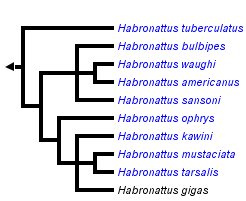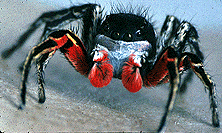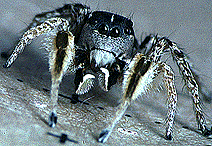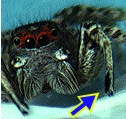Habronattus americanus group
Wayne Maddison


This tree diagram shows the relationships between several groups of organisms.
The root of the current tree connects the organisms featured in this tree to their containing group and the rest of the Tree of Life. The basal branching point in the tree represents the ancestor of the other groups in the tree. This ancestor diversified over time into several descendent subgroups, which are represented as internal nodes and terminal taxa to the right.

You can click on the root to travel down the Tree of Life all the way to the root of all Life, and you can click on the names of descendent subgroups to travel up the Tree of Life all the way to individual species.
For more information on ToL tree formatting, please see Interpreting the Tree or Classification. To learn more about phylogenetic trees, please visit our Phylogenetic Biology pages.
close boxIntroduction
The americanus group includes some of the most colorful species of salticids. This primarily western group is recognized by the form of its palpus, the black first tarsus, and its remarkable ornaments on the face and palpi. In several of the named species (americanus, sansoni, tarsalis), there is strong geographic differentiation, to the extent that many more species may eventually be recognized in this group.
Characteristics
The americanus group has a distinctive palpus, both in having the bulb only slightly rotated counterclockwise from the condition in the related genus Pellenes, and in having a distinctively shaped tegular apophysis. In addition, the first legs are somewhat long and the tarsal area has a black scopula (see figure).
The ornaments consist of a typically fringed first leg, striped or colored cymbium, and high clypeus that may be striped, metallic blue or green, or otherwise colored. Long setae on the clypeus extend forward from the face, and setae around the front eyes often make an eyebrow or other tuft. Except for H. americanus and H. waughi, the latter of which reaches the Atlantic coast of Canada, all species are western.
References
Griswold, C. E. 1987. A revision of the jumping spider genus Habronattus F.O.P.-Cambridge (Araneae; Salticidae), with phenetic and cladistic analyses. University of California Publications, Entomology 107: 1-344.
Title Illustrations

| Scientific Name | Habronattus americanus |
|---|---|
| Location | Mt. Pinos, California, USA |
| Specimen Condition | Live Specimen |
| Sex | Male |
| Copyright |
© 1994-1995 Wayne Maddison

|
| Scientific Name | Habronattus tarsalis |
|---|---|
| Location | Bishop, California, USA |
| Comments | may actually be nearer kawini |
| Specimen Condition | Live Specimen |
| Sex | Male |
| Copyright |
© Wayne Maddison

|
About This Page
Wayne Maddison

University of British Columbia, Vancouver, British Columbia, Canada
Correspondence regarding this page should be directed to Wayne Maddison at
Page copyright © 1995 Wayne Maddison
All Rights Reserved.
Citing this page:
Maddison, Wayne. 1995. Habronattus americanus group. Version 01 January 1995 (under construction). http://tolweb.org/Habronattus_americanus_group/3998/1995.01.01 in The Tree of Life Web Project, http://tolweb.org/










 Go to quick links
Go to quick search
Go to navigation for this section of the ToL site
Go to detailed links for the ToL site
Go to quick links
Go to quick search
Go to navigation for this section of the ToL site
Go to detailed links for the ToL site